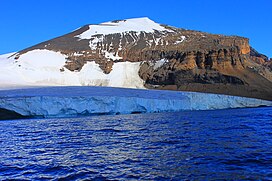| Brown Bluff | |
|---|---|
 Brown Bluff as seen from Antarctic Sound | |
| Highest point | |
| Elevation | 745 m (2,444 ft)[1] |
| Listing | List of subglacial volcanoes List of volcanoes in Antarctica |
| Coordinates | 63°32′S 56°55′W / 63.533°S 56.917°W[1] |
| Geography | |
| Geology | |
| Mountain type | Tuya |
| Volcanic field | James Ross Island Volcanic Group |
| Last eruption | Pleistocene |
Brown Bluff is a basalt tuya on the Tabarin Peninsula of northern Antarctica.[2] It formed in the last 1 million years as a result of subglacial eruptions within an englacial lake. The volcano's original diameter is thought to have been about 12–15 kilometers (7.5–9.3 mi) and was probably formed by a single vent. Brown Bluff is divided into four stages: pillow volcano, tuff cone, slope failure, and hyaloclastite delta; and into five structural units.[3]
The volcano gets its name from its steep slopes and brown-to-black hyaloclastite. It was applied by the Falklands Islands Dependencies Survey following their survey in 1946.[1]
- ^ a b c
 This article incorporates public domain material from "Brown Bluff". Geographic Names Information System. United States Geological Survey.
This article incorporates public domain material from "Brown Bluff". Geographic Names Information System. United States Geological Survey.
- ^ Elias, Scott A.; Mock, Cary J. (2013). Encyclopedia of Quaternary Science. Elsevier.
- ^ Skilling, I. P. (1994). "Evolution of an englacial volcano: Brown Bluff, Antarctica". Bulletin of Volcanology. 56 (6–7): 573–591. Bibcode:1994BVol...56..573S. doi:10.1007/BF00302837. S2CID 128894569.

